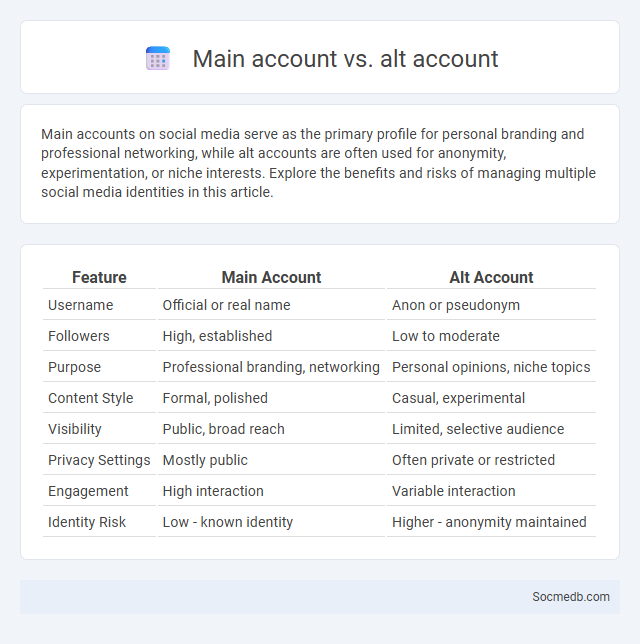
Photo illustration: Main account vs Alt account
Main accounts on social media serve as the primary profile for personal branding and professional networking, while alt accounts are often used for anonymity, experimentation, or niche interests. Explore the benefits and risks of managing multiple social media identities in this article.
Table of Comparison
| Feature | Main Account | Alt Account |
|---|---|---|
| Username | Official or real name | Anon or pseudonym |
| Followers | High, established | Low to moderate |
| Purpose | Professional branding, networking | Personal opinions, niche topics |
| Content Style | Formal, polished | Casual, experimental |
| Visibility | Public, broad reach | Limited, selective audience |
| Privacy Settings | Mostly public | Often private or restricted |
| Engagement | High interaction | Variable interaction |
| Identity Risk | Low - known identity | Higher - anonymity maintained |
Introduction to Main and Alt Accounts
Main social media accounts serve as your primary digital identity, representing your official brand or personal presence with consistent content and engagement. Alternative (alt) accounts provide flexibility for experimenting with different content styles, niche interests, or private interactions without affecting the reputation of your main profile. Managing both types efficiently allows you to target diverse audiences while maintaining clear boundaries between personal and professional online activities.
Defining Main Account: Features and Purpose
Your main social media account serves as the central hub for personal branding and online presence, featuring a profile optimized with a clear username, profile picture, and bio that encapsulates your identity or business. It provides access to core functionalities such as posting updates, engaging with followers, and managing privacy settings to control audience reach. This primary account is designed to build and maintain connections, promote content, and represent your digital persona effectively across platforms.
What is an Alt Account?
An alt account, short for alternative account, is a secondary social media profile created by a user to separate content from their main account. These accounts provide anonymity or allow users to engage in niche communities without associating with their primary identity. Common uses include testing new strategies, sharing specialized interests, or maintaining privacy on platforms like Twitter, Instagram, and TikTok.
Types of Alt Accounts
Alternative accounts on social media include burner accounts, used for anonymous browsing or posting without linking to your primary identity, and secondary accounts, which serve specific purposes such as niche interests or business activities. Fake accounts, often created for testing or trolling, differ from sockpuppet accounts designed to manipulate discussions by pretending to be different users. Your strategic use of these alt accounts can help maintain privacy and manage multiple personas effectively across platforms.
Main Account vs Alt Account: Key Differences
Main accounts on social media serve as your primary digital identity, often linked to personal information, contacts, and regular interactions. Alt accounts provide anonymity, allowing experimentation with different content or exploring niche communities without affecting your main profile's reputation. Understanding these key differences helps you manage privacy, engagement strategies, and content diversity effectively.
Advantages of Using a Main Account
Using a main social media account consolidates your personal brand, making it easier to maintain a consistent online presence and engage authentically with your audience. Your main account often has higher credibility and better access to platform features like analytics, advertising tools, and customer support. Managing interactions through a single account enhances trust and simplifies networking, maximizing the impact of your social media efforts.
Benefits and Risks of Alt Accounts
Using alternative social media accounts can enhance your online privacy and allow you to explore different interests without affecting your main profile. These accounts provide an opportunity for experimentation with content or interactions, helping to maintain your personal brand's integrity. However, risks include potential security vulnerabilities, difficulty in managing multiple identities, and the chance of confusing followers or damaging your credibility if content is inconsistent.
Common Reasons for Creating Alt Accounts
Many users create alternate social media accounts to maintain privacy and separate personal from professional life, ensuring that sensitive information is shared selectively. Others use these accounts for exploring different interests, hobbies, or communities without affecting their primary online identity. Additionally, alt accounts serve as a way to manage multiple personas or engage in anonymous interactions while avoiding potential social or professional repercussions.
Security and Privacy: Main vs Alt Accounts
Main social media accounts typically contain personal information and are more vulnerable to privacy breaches and targeted cyberattacks. Alternative accounts serve as a safeguard by allowing users to share content anonymously or limit exposure, reducing risks associated with identity theft or data leaks. Employing strong passwords, enabling two-factor authentication, and regularly reviewing privacy settings are essential practices to secure both main and alternate profiles effectively.
Choosing the Right Account Strategy
Selecting the right social media account strategy is essential for maximizing your brand's reach and engagement. Tailoring your approach to target audiences, platform algorithms, and content types enhances visibility and drives meaningful interactions. Your strategy should align with business objectives, whether focusing on personal branding, community growth, or customer service.
 socmedb.com
socmedb.com